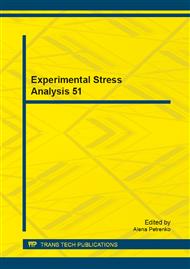[1]
W. Fuchs, R. Eligehausen, J. E. Breen, Concrete capacity design (CCD) approach for fastening to concrete, ACI Struct.J., 92, 1, ACI, (1995).
DOI: 10.14359/1533
Google Scholar
[2]
Comité Euro-International du Béton, Design of Fastenings to Concrete, Thomas Telford Services Ltd., London, (1997).
Google Scholar
[3]
J. Ožbolt, R. Eligehausen, G. Periškić, U. Mayer, 3D FE analysis of anchor bolts with large embedment depths, Fracture of Concrete Materials and Structures, Eng. Fract. Mech., 74, 1–2, 2007, pp.168-178, 0013-7944.
DOI: 10.1016/j.engfracmech.2006.01.019
Google Scholar
[4]
R. Eligehausen, G. Sawade, A fracture mechanics based description of the pull-out behavior of headed studs embedded in concrete, Fracture mechanics of concrete structures;, London : Chapman and Hall, 1989, pp. pp.281-299, 0-412-30680-8.
Google Scholar
[5]
R. Eligehausen, P. Bouska, V. Cervenka, R. Pukl, Size effect of the concrete cone failure load of anchor bolts, In: Bazant Z. (Ed. ), Fracture mechanics of concrete structures : FraMCoS1. London, London ed., Elsevier Applied Science, ISBN 1-85166-869-1, 1992, pp. pp.517-525.
Google Scholar
[6]
P. Pivonka, R. Lackner, H. A. Mang, Concrete subjected to triaxial stress states: Application to pull-out analyses, J. Eng. Mech., 130, 12, American Society of Civil Engineers, 2004, pp.1486-1498.
DOI: 10.1061/(asce)0733-9399(2004)130:12(1486)
Google Scholar
[7]
R. W. Cannon, E. G. Burdette, R. R. Funk, T. V. Authority, Anchorage to concrete, Tennessee Valley Authority, Division of Engineering Design, Thermal Power Engineering, (1975).
Google Scholar
[8]
ACI Committee 349, Code Requirements for Nuclear Safety Related Concrete Structures (ACI 349-90), American Concrete Institute, Farmington Hills, Mich, (1990).
DOI: 10.14359/10473
Google Scholar
[9]
BSI Committee, DD CEN/TS 1992-4-2: 2009, Design of fastenings for use in concrete, Part 4-2: Headed Fasteners, BSI Group, London, (2009).
DOI: 10.1002/9783433602737.ch9
Google Scholar
[10]
R. Cannon, D. Godfrey, F. Moreadith, Guide to the design of anchor bolts and other steel embedments, Concr. Int., 3, 7, 1981, pp.28-41.
Google Scholar
[11]
V. Červenka, L. Jendele, J. Červenka, ATENA Program Document. –Part 1: Theory, Cervenka Consulting, Prague, (2007).
Google Scholar
[12]
CEB-FIP, Model Code 1990, First Draft ed., Comitte Euro-International du Beton, Bulletin d´information No. 195, 196, Mars, (1990).
DOI: 10.1680/ceb-fipmc1990.35430
Google Scholar
[13]
E. Vos, Influence of Loading Rate and Radial Pressure on Bond in Reinforced Concrete. A Numerical and Experimental Approach, Delft University, (1983).
Google Scholar
[14]
J. Fornusek, P. Konvalinka, Numerical investigation of head diameter influence on tensile capacity of headed studs, Business, Engineering and Industrial Applications (ISBEIA), 2012 IEEE Symposium, IEEE, 2012, pp.737-741.
DOI: 10.1109/isbeia.2012.6422988
Google Scholar


